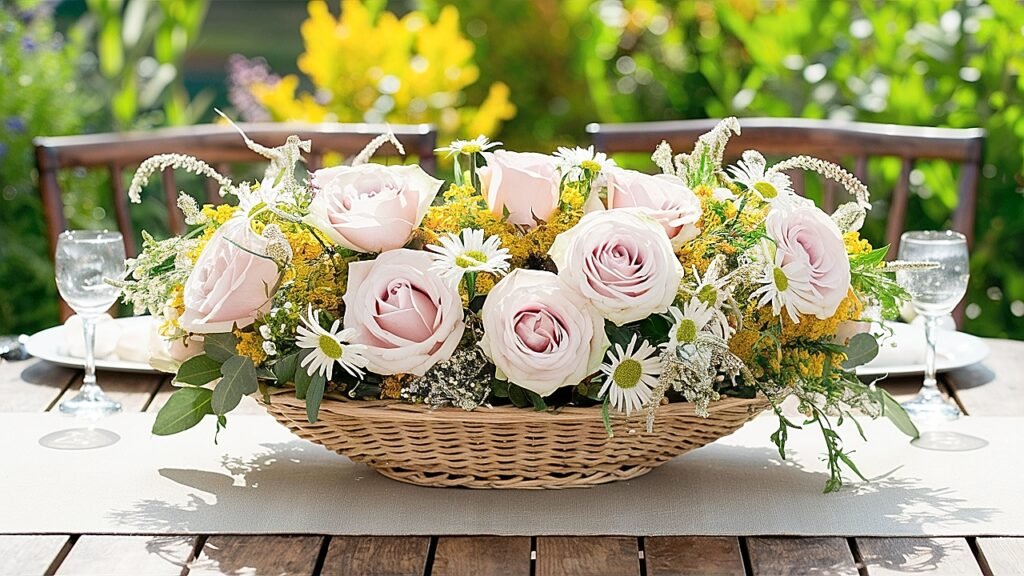
This website contains affiliate links, and some products are gifted by the brand to test. As an Amazon Associate, I earn from qualified purchases. Some of the content on this website was researched and created with the assistance of AI technology.
Key Takeaways:
- Farm-to-table elements like fruits, herbs, rustic containers and edible garnishes add organic charm and freshness to rose centerpieces.
- Choose fruits that complement rose hues and have a soft, romantic appearance.
- Fresh herbs provide an aromatic dimension and rustic appeal when combined with roses.
- Repurpose vintage tins, crates and milk glass for an authentic farm-to-table vessel.
- Garnish with edible flowers, textured greens and even vegetables for multi-sensory impact.
What Are Farm-to-Table Elements, and How Can They Enhance Rose Centerpieces?
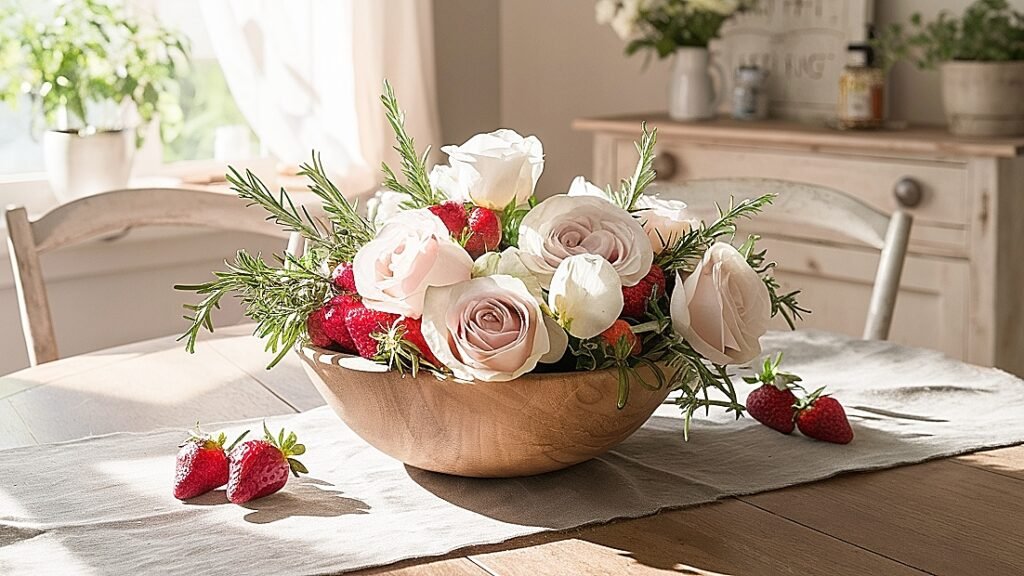
At its core, farm-to-table floral design simply means sourcing as many natural botanicals, fruits, vegetables and container materials as possible from local growers, farmer’s markets or even one’s own backyard harvests. But it’s about so much more than just food miles and carbon footprints (though those are great benefits too!).
From juicy seasonal fruits plucked straight off the bramble to pungent just-snipped herbs, fragrant flowering vines and unique repurposed vintage containers – every organic addition allows the garden’s essence to seamlessly blend with those luscious rose blooms. It just feels so authentic having those hand-cultivated ingredients provide depth, dimension and rustic flair as supporting cast members to my signature long-stemmed divas.
Seasonal Farm-to-Table Elements for Rose Centerpieces
| Season | Suggested Fruits | Suggested Herbs | Suggested Greenery |
|---|---|---|---|
| Spring | Lemons, Strawberries | Mint, Thyme | Fern, Eucalyptus |
| Summer | Peaches, Blueberries | Basil, Lavender | Salal, Ivy |
| Autumn | Apples, Pears | Sage, Rosemary | Magnolia Leaves, Oak |
| Winter | Oranges, Cranberries | Pine, Bay Leaves | Holly, Cedar |
What Fruits Pair Best with Roses for a Farmhouse Look?

- Blackberries (rich, moody hues and rustic texture)
- Figs (lush, romantic shapes and deep purple shades)
- Apples (nostalgic farmhouse charm in endless varieties)
- Pears (soft green hues and elegant, elongated forms)
- Citrus (zesty fragrance and vibrant pops of color)
- Grapes (cascading, organic shapes and succulent translucence)
- Berries (jewel-toned bursts of flavor and color)
Depending on the cultivar, rose colors and floral forms can span the entire spectrum from soft, romantic pastels to rich, saturated hues and dramatic textures. That incredible versatility also makes them remarkably amenable to blending with a wide variety of seasonal fruits for centerpiece designs radiating quintessential farmhouse appeal.
For lush, romantic tablescapes, you can’t go wrong combining deep burgundy rose varieties like Black Baccara and Fallat Red with equally luxe blackberries, figs, dark plums and even glossy eggplant accents. Those bountiful purple, maroon and inky jewel tones juxtaposed against velvety rose petals look downright sumptuous while introducing layers of ripe, enticing fragrance.
For romantic antiqued appeal, ruby-hued figs or deep burgundy-black plums provide such an undeniably lush foil for rich rose tones. While cheerful, sun-ripened peaches and apples lend uplifting kitchen garden whimsy to soft peachy-pink floral arrangements. For more farm-to-table ideas, check out this comprehensive guide on foraged Florals & Wild Edibles. Don’t forget to share with friends too!
How Can I Use Fresh Herbs to Complement Roses in Centerpieces?
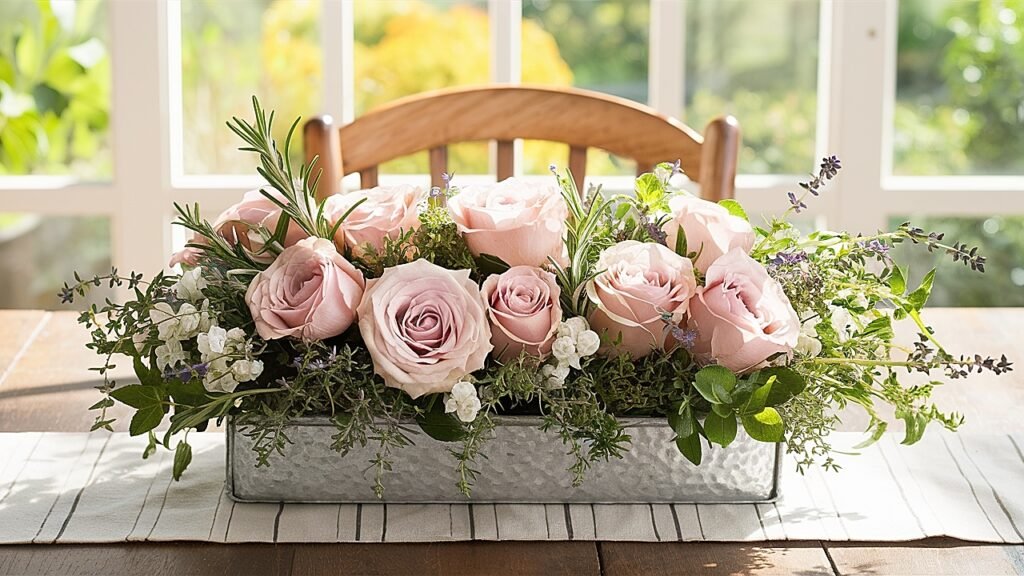
For me, integrating a rich melange of freshly-snipped herbs is an absolute must for dialing up the garden-fresh appeal of any rose centerpiece design. Their aromatic, nuanced fragrances have a way of elevating the overall sensory experience in a way synthetic floral scents simply can’t match. Plus, those feathery stems and blossoms provide soft romantic texture that mingles so beautifully with lush rose petals.
One of my personal signature moves is tucking slender rosemary sprigs amid deep crimson rose centerpieces. Not only do those delicate blue blooms echo the rose tones with understated charm, but the earthy, resinous fragrance casts an unmistakably Mediterranean-inspired spell too. For a softer, more ethereal effect, I can’t resist layering in cascading jasmine trails alongside billowy garden roses or sweet pea vines. Or for maximalist opulence, I love mounding lush lavender throngs among peony centerpieces for double the French countryside sumptuousness.
But let’s not overlook the true workhorses of the edible herb world like basil, sage, mint and dill either! These humble yet hardworking botanical accents are incredibly versatile for adding rustic texture through their leafy stems and umbels. They also lend grounding earthiness with their complex greenery aromas – the perfect counterpoint to rose centerpieces’ sweet floral intensity.
What Rustic Containers Enhance Farm-to-Table Rose Centerpieces?
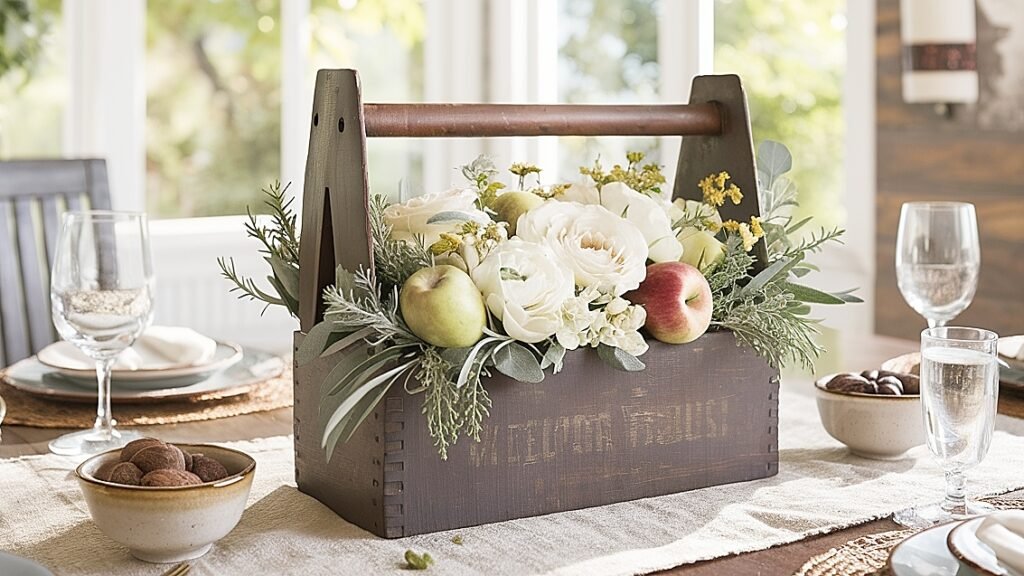
- Vintage Galvanized Tins (weathered patinas, rugged farmhouse romance)
- Repurposed Wooden Crates (timeworn charm, agrarian authenticity)
- Antique Ceramic Crocks (handmade artistry, nostalgic rustic warmth)
- Milk Glass Vases (heirloom cottage appeal, soft romantic femininity)
- Artisan Pottery Vessels (organic crafted shapes, naturalistic sophistication)
While classic clear glass vases and sleek ceramic containers will always have their place, I find there’s simply no substitute for repurposed farmhouse-inspired vessels when it comes to channeling true rustic, farm-to-table flair. Their timeworn character and organic backstories lend so much authenticity to botanical arrangements!
Like many florists, I have a serious soft spot for galvanized metal objects sporting those gorgeous weathered blue-green patinas. From distressed tins and buckets to laborer’s pails and beverage tubs, their rugged yet dreamily dilapidated finish provides the perfect foil for silky rose blooms and tendriled herbs. They’re like poetic tributes to pastoral landscapes and grueling agricultural labor of generations past.
No matter your personal style, a little curatorial thoughtfulness with your chosen farm-to-table vessel can speak volumes. So indulge those antiquing impulses and click here to browse my comprehensive Farm Antique Floral Container Guide chock full of history-steeped treasures!
What Are the Best Edible Elements to Add Depth to a Rose Centerpiece?
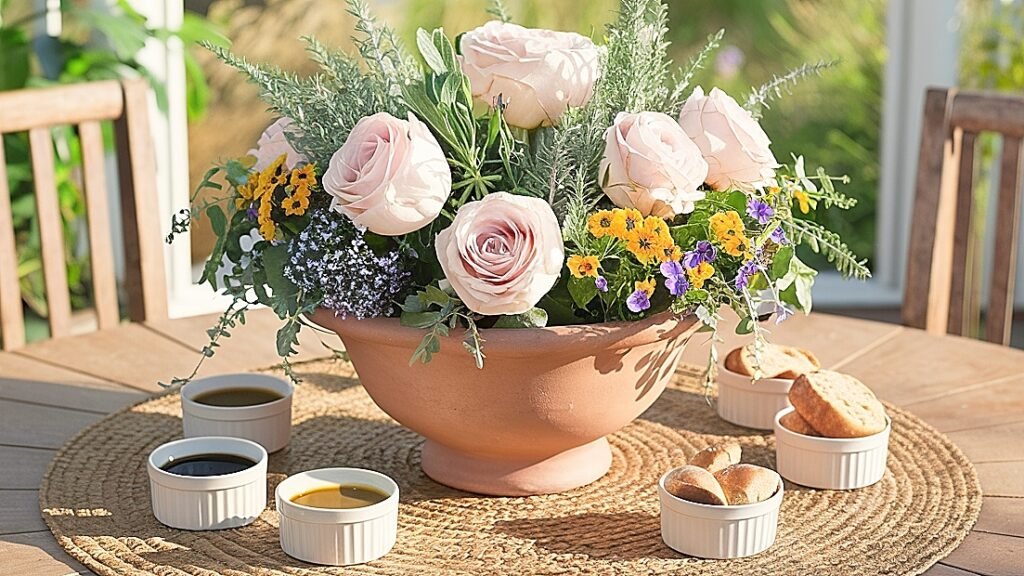
- Flowering Herbs (edible blossoms, fragrant whimsy, rustic informality)
- Fresh Produce (heirloom vegetables, fruits, bright tones and textures)
- Wholesome Grains (wheat, oats, farm-fresh cozy comfort)
Of course, we’d be remiss to discuss incorporating farm-to-table elements into rose arrangements without spotlighting Mother Nature’s edible gems! Not only do these ingredients provide lush botanical texture, but they engage all the senses with their tempting hues, intriguing shapes and even their familiar aromas can stir up nostalgic comfort.
Let’s start with those enchantingly quaint flowering herbs like chives, fennel, dill, cilantro and sage. Their diminutive bulbous blossoms scattered amid small rose centerpieces infuse the most charming just-picked-from-the-garden spirit! Plus those mild onion-y notes lend earthy fragrance to balance out roses’ decadence. For an ultra fresh garnish, you could even snip a few tendrils straight over an arrangement’s candles before guests arrive!
From there, sampling homegrown produce like radishes, celery, carrots, tomatoes and artichokes can dial up the “locally-sourced” factor through their vibrant jewel tones. I’m talking long branchy fronds unfurling alongside peach-hued garden roses or tightly clustered cherry tomatoes spilling across tabletops like untamed vines! And who could resist the farm-fresh nostalgia of nubby wheat stalks bristling up through velvety red rose petals for peak countryside reverie?
How to Incorporate Edible Greens in a Rose Arrangement?
From textural leafy fronds and airy wispy tendrils to robust trailing vines and silvery bursts, these modest beauties serve as the ultimate supporting cast.
On a fundamental level, lush greens provide that essential framework for elevating rose arrangements from flat, one-dimensional displays to three-dimensional living artworks. By having those organic fronds and vines billow out asymmetrically, you create intentional negative space that directs the eye toward floral focal points.
But beyond that, thoughtfully choosing greens for their varied textures, tones and pliability brings in intriguing depth too. Like loosely twisting together oregano stems and Italian parsley with their broad flat leaves to snake around centerpieces. Or allowing long, fountaining curly willow branches to spill over tabletops with carefree abandon among centerpiece roses. Even humble elements like soft, feathery dill sprigs offer a naturalistic, from-the-garden charm when peeking through red rose bouquets.
How to Create a Farm-to-Table Centerpiece for Outdoor Gatherings?

For ultra-casual outdoor affairs, I can’t resist the allure of assembling an abundant “centerpiece” by filling low, vintage berry trays or wooden crates with an overflowing bounty of freshly plucked meadow blooms, orchard fruits, greenery swags and interesting vegetable varietals. That sense of an effortless, garden-gathered moment instantly sets the tone.
You can definitely get more structured by lining slender rectangular boxes with Plexi or glass panes and then layering plump figs, persimmons, rosy apples and soft billows of roses into an undeniably craveable trough centerpiece. The transparency creates a vibrant display viewable from all angles. For circular tables, aged terracotta bowls overflowing with heritage grains, lush garden roses, trailing blackberry canes and fuzzy scabiosa makes for a rustic, bountiful tablescape brimming with botanical luxury.
If you’re after more of a streamlined farmhouse moment, consider sourcing long repurposed wooden troughs or planters to create a continuous, linear “runner” arrangement of greenery swags interspersed with dainty bud vases capturing fresh-snipped roses, sweet peas, chamomile and sprigs of lavender.
To achieve this, I dig deep into locally-grown seasonal blooms and foraged accent pieces specific to our geographic region. Here in the Mediterranean countryside, that might translate to olive branches, trailing rosemary vines and fruit like figs or grapes nestled among my signature dusty orange-red rose varieties. While New England weddings call for integrating maple seeds, pinecones, bittersweet branches and heirloom apples into lush magenta rose centerpieces.
I also embrace the spirit of agritourism by filling rustic containers like apple crates or vegetable punnets with rose overflows for an “urban homestead” vibe. And don’t be afraid to scatter smaller potted plants like fragrant jasmine, lavender or herbs in between dining spaces – their natural aromatics will intoxicate the senses!
At the end of the day, immersing guests in an intentionally curated botanical ecosystem honoring your local land’s beauty and bounty is what outdoor farm-to-table tablescapes should embody. For more regional specificity, definitely give my comprehensive Seasonally-Inspired Centerpiece Guide a peruse too!
Conclusion
Well, there you have it, my fellow floral fanatics! A veritable masterclass on infusing lavish rose centerpieces with locally-grown, farm-fresh flair. From sourcing vibrant seasonal botanicals and repurposed farmhouse vessels to layering in mouthwatering fruits, fragrant herbs and homegrown produce, every carefully considered element should stir up nostalgic rural reveries.
So go forth and marry your beloved roses with the bounty of each changing season. I promise every centerpiece infused with fresh herbs, lush greenery, colorful fruits and rustic “plated” charme will leave your guests utterly spellbound. Like they just stumbled into a transcendent pastoral fantasy brought vividly, soulfully to life!
This website contains affiliate links, and some products are gifted by the brand to test. As an Amazon Associate, I earn from qualified purchases. Some of the content on this website was researched and created with the assistance of AI technology.
